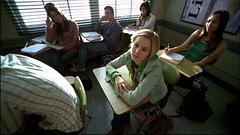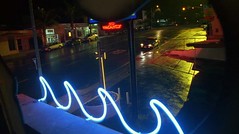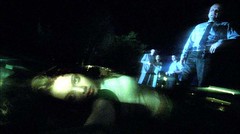Kehr, and in response to him David Bordwell, discuss Soderbergh's new film in terms of its adoption of classical-era conventions of visual technique, especially camerawork, staging and composition. In David's blog entry on the topic, he goes into considerable detail about norms of lens use and staging that have changed in the decades since the demise of the old studio system. Jason observes that this line of discussion is different from how most people ordinarily talk about television:
in reading these articles, it becomes clear that Soderbergh, Bordwell, and NYT critic Dave Kehr have an intiuitive mode of engagement with cinematic style - as they watch a movie, they see the camera & its lens, not just the image being captured. I don't have that visual acuity, or at least I have to work hard at it to notice such details as focal length, perspective, offscreen space, and staging composition. My default mode of viewing focuses on narrative techniques, genre, and sound, and I thus often enjoy films whose visual style is not particularly compelling or even effective.Jason observes as well that he thinks of himself as
a "better" critical viewer of television than film, as the medium seems to play to my strengths of formal engagement. What do these distinctions mean for our understanding of the differences between film & television?I see here 3 claims about differences between TV and film: 1. Jason (a television scholar) doesn't pay attention to the same things in TV that film critics and scholars pay attention to in films; 2. Television does not reward attention to visual qualities as much as cinema does; 3. Television does reward attention to non-visual qualities as much or more than cinema does. (There is also the claim that contemporary American television is better than contemporary American film, but this is a matter of aesthetic judgment rather than of diverging modes of viewing.)
I would argue with anyone willing to listen that contemporary American fictional television is much better than contemporary American cinema, both on average and at its peaks. My lines of attack would be trumpeting the superiority of television's strategies of complex narrative, thematic sophistication, originality of ideas, depth of performance, and effective use of music. But I wouldn't even engage a discussion about visual style[...]this is not why I watch TV. Even shows that I'd argue "look good" (Lost, Six Feet Under, Alias) or use their particular styles to good effect (The Office, Battlestar Galactica, Scrubs) seem not to be in the business of dealing out particularly visual pleasures. There's a long list of reasons for why television has historically rarely focused its creativity on visual style - tight production schedules, tight budgets, creative control by writers rather than directors, small screens with poor resolution, norms of multi-camera studios, ephemeral nature of series - but many of these norms have changed or at least loosened.
[...]
Critics make bad seers into the future, but my hunch is that this medium divide will more likely deepen rather than blur - cinema will remain the home for compositional beauty (as well as fart jokes and big explosions), while television will thrive on its writing and acting (with fart innuendos and smaller explosions). And I think I'm okay with that.
1. It makes sense that people who study TV would have a different mode of engagement than film scholars because their training is often different. Jason and I are graduates of the same department, Communication Arts at UW-Madison, but he studied in the area that used to be called telecommuninications and is now called media and cultural studies, while I studied in the area called film studies. Although we took courses with some of the same professors (he with David; I with John Fiske), our scholarly orientations are the product of our training. As Jason himself once mentioned to me, it's emblematic of the difference between film and TV studies at the University of Wisconsin-Madison that Bordwell's best-known book is called Film Art and Fiske's is called Television Culture. The emphasis in studying television in our department was cultural; the emphasis in studying film was aesthetic. (It's true that art is a kind of culture but you get the idea.)
My sense is that writing about television and film in the popular and trade press follows the distinction Jason draws. Film critics more often refer to a director's visual signature and to elements of cinematography (e.g., Variety makes references to production design and "lensing" a standard component of its film reviews but typically ignores these visual elements in its TV reviews). As the aesthetically more respectable of the two media, cinema must seem to warrant closer scrutiny as a form of visual art.
If Jason approaches cinema as a television viewer, I approach television as a film viewer. When I watch TV (which these days I watch much more often than film), I do intuitively see the camera and lens. I see choices of how to stage and compose the image, how to light the sets and figures, how to cut the scene. And I do find that my attention to these things is rewarded, which brings me to the second claim.
2. Veronica Mars is one show that consistently uses distinctive and compelling visual techniques, especially cinematography and staging. One of its signature styles is the short-lens shot with distorted perspective and accentuated depth. In the first season, this technique underlines our sense of Veronica's distance from the other kids at school, who ostracize her because of her father's mishandling of the investigation into the murder of her best friend (he was the Sheriff).

In the classroom shot above (like all of these VM caps, it's from ep 1.1), the overhead framing and the use of a short ("wide angle") lens emphasize this isolation. The image's skewed perspective allows us to take in the various gazes of Veronica's classmates and also functions to pluck her out of the crowd as the main character and fasten our attention on her.
Aggressive depth staging, in combination with voice-over narration and a mystery plot, helps give the show its noirish tone. Shadowy deep space is associated with hard-boiled Hollywood films of the 40s and 50s and Veronica's use of a similar visual style harks back to those movies and puts us on similar thematic terrain (crime, seduction, moral ambiguity, etc.). In this shot, the neon waves and "no vacancy" sign and the rain-slicked night street scene also work in this tradition. (The car in the distance is Veronica's as she pulls up to stake out Jake Kane.)

In its first season, Veronica Mars uses regular flashbacks to fill in the story of the murder, which is a mystery that runs through the whole year of episodes. Rob Thomas and his crew mark these off using various techniques of framing, lighting and post-production effects, not only clarifying the patterns of storytelling but also giving the past events an horrific aura. For example, consider this shot of Keith Mars standing over Lily Kane's body, with its dramatic tonal contrast and its effect of characters unnaturally aglow against the black of night. The scene is shot from a canted angle to show an extreme situation that sets us off kilter, and it pushes low-angle depth to an uneasy point reminiscent of the ending of Touch of Evil. Stylization like this not only engenders strong emotion effects, but demands to be noticed.

It may seem that Veronica Mars and other "quality" programs would be better candidates than most television shows for aesthetic appreciation, but I wouldn't be so quick to assume that. Some of the most impressive technical achievements in television style are in the reality genre, which few critics regard as TV's best. Laguna Beach, for example, offers up a steady succession of bikini tilts, aerial shots swooping down over the beach, real estate porn, and golden sunsets. Consider these shots, some of which are interstitials used in transition from scene to scene.

If there is not art in these images (and if you think there isn't, why not?), at least there is beauty. One key appeal of this show is its displays of the luxe life enjoyed by its gorgeous rich kid "characters." This magic-hour scene from the finale of Laguna's first season (into which some of the images above are cut), when Kristen and Stephen break up while staring out at a dramatic sunset, offers us not only the red and golden hues of the ocean sky, but also the contemplative pretty faces of our youthful TV friends (or TV nemeses?). The appeals of Laguna Beach are many; some of them are undoubtedly "compositional beauty" and "visual pleasures."

3. I am in complete agreement that television has appeals that cinema lacks. The one that seems most significant to me is extended characterization. Not only are television texts much longer than films (some stretch into the hundreds of hours), but our experience of their narratives is continual. We track them week by week, season by season. We get to know the people so well, we feel we know them like our friends and family. Thus one commentator remarked of the most recent Gilmore Girls episode, in which Emily tells Lorelai that she must take her new marriage seriously, that this "will no doubt give Lorelai a lot to think about over the holidays." In my English major days I was admonished not to talk about fictional characters as though they are real people, but this kind of thinking is practically the norm in discussions of television characters.
Still, I don't see any reason to think that investment in character (or the other appeals Jason lists) trumps visual pleasures. There are lots of reasons to love television, but I don't think it profits those of us who want to take TV seriously in aesthetic terms to cede to cinema the whole visible realm. TV's means of representation are visual, and television's makers invest great time and resources in getting their shows to look the way they want. Television stars are handsome and beautiful--so handsome and beautiful, many of them also have successful movie careers. Many prime-time television shows also boast flashy visual design, as in the gadget fetish imagery of some procedurals, the multiple screens of 24, the jittery vérité of Friday Night Lights, and the extravagantly stylized Cylon ship of Battlestar Galactica. Finally, conventions in visual style flow not only from film to TV, as in the adoption of classical continuity editing, but also from TV to film, as in the style of cutting credited to MTV videos, the two-camera style of Homicide: Life on the Street using shots that cross the 180-degree line, and the "energized" walk-and-talk technique on shows like ER and The West Wing. (All of these are trends that Bordwell discusses in his book The Way Hollywood Tells It). Although their production practices differ as do some basic conventions of storytelling, Hollywood films and prime-time network television shows (and original cable series) share not only an apparatus but also many standard visual techniques.
These two media--if indeed they are distinct media--have so much in common that it's hard to assess their differences. I hope to have more to say about this in future posts.
1 comment:
Mike - thanks for the thoughtful reply. I agree with most of your points, with a few clarifications. I'd attribute my own attentions toward narrative & sound and away from visuals not to training per se (as I think the cultural studies focus of my education was equally uninterested in form of all stripes), but my own hard-wiring. What might be true is that my tendencies toward issues of narrative & dialog drew me toward TV as a site of analysis, whereas other folks (like you) felt film pulling at your visual sensitivity.
I agree that TV can do interesting things with visual style, although your choice of a pilot is telling, as pilots afford the most time & money to experiment. On the other hand, this semester I showed the pilot of Veronica Mars to my TV class. The most accomplished film student in the class, with a terrific eye, absolutely hated the show based on its look. For me, its visual pleasures are always ranked beneath its narrational, character, emotional, and sonic ones - they're there, but not centrally. Is it my own spectatorship or the show itself? I can't say...
I look forward to the ongoing conversation!
-Jason
Post a Comment